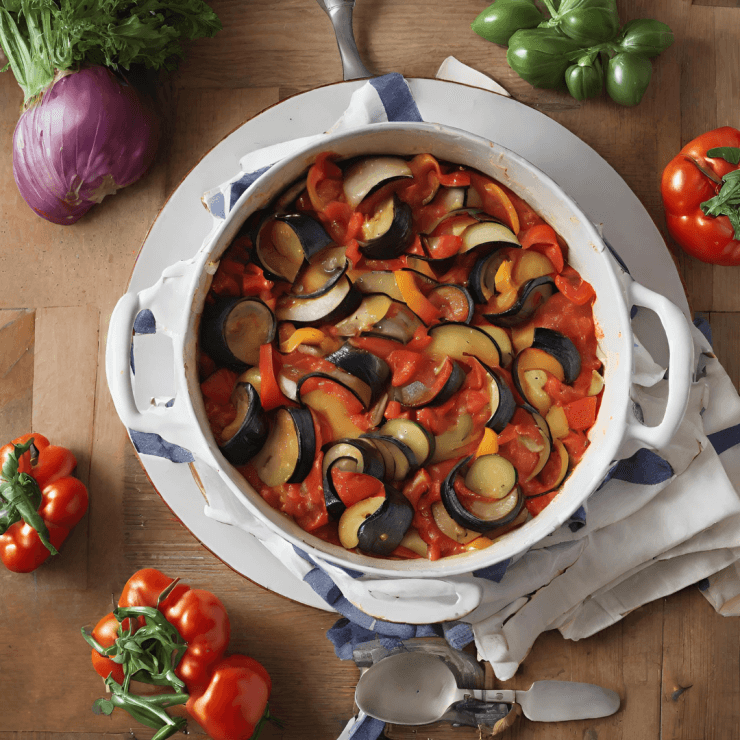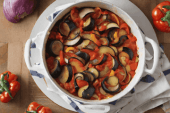
Late summer in my garden is pure magic — that golden time when the eggplants hang heavy and glossy, the zucchini seems to multiply overnight, and my tomato vines are so loaded with fruit I can barely keep up. It’s during these abundant weeks that I find myself making ratatouille almost weekly, a dish that feels like the garden’s own love letter to itself.
Julia Child once said that ratatouille embodies the heart and soul of French cooking, and I couldn’t agree more. But what she understood so brilliantly was that this rustic Provençal stew isn’t about following rigid rules — it’s about celebrating whatever vegetables are at their peak. When I walk through my garden with a basket, letting the plants tell me what’s ready, I’m following the same instincts that French home cooks have trusted for generations.
The beauty of ratatouille lies in its contradictions. It’s humble yet elegant, simple yet complex. Each vegetable maintains its distinct character while melding into something greater than the sum of its parts. The eggplant becomes silky and absorbs all the flavors around it, while the zucchini holds its gentle bite. The peppers add sweetness, the onions provide depth, and those ripe tomatoes create the luxurious base that ties everything together.
What I love most about making ratatouille from my own garden is how the dish changes with each harvest. Early in the season, when my baby eggplants are still tender-skinned, the dish has a different character than later when I’m using the full-sized beauties. The small, sweet cherry tomatoes from my patio containers create a different sauce than the meaty paste tomatoes from the main garden. Each version tells its own story.
The technique itself is meditative — the careful salting and draining of the eggplant, the patient sautéing of each vegetable to bring out its best qualities, the gentle layering that lets everything meld without losing individuality. Julia Child was right when she said ratatouille is a labor of love, but it’s the kind of labor that connects you directly to the seasons, to the soil, and to centuries of cooks who understood that the best dishes come from treating simple ingredients with respect and patience.
Print
Julia Child’s Ratatouille
Julia Child’s Ratatouille stands out as a culinary masterpiece that captures the essence of Provençal flavors and showcases the artistry of French home cooking.
- Prep Time: 30 minutes
- Cook Time: 30 minutes
- Total Time: 1 hour
- Yield: 6-8 servings 1x
- Category: Entrées
Ingredients
- Eggplant: 1 lb.
- Zucchini or Summer Squash: 1 lb.
- Olive Oil: 4-6 Tbsp. (divided)
- Salt: 1 tsp.
- Mashed Garlic: 2 cloves
- Yellow Onions: About 1 1/2 cups or 1/2 lb. (thinly sliced)
- Salt & Pepper: to taste
- Green Bell Peppers: 2 (about 1 cup, sliced)
- Minced Parsley: 3 Tbsp.
- Red Tomatoes: 1 lb. (Make sure they are ripe, firm, seeded, peeled, and juiced! Roma tomatoes work well here.)
Instructions
- Peel and cut the eggplant into lengthwise slices that are about 1-inch wide, 3-inch long, and 3/8-inch thick.
- Scrub the summer squash and cut into pieces the same size as the eggplant.
- Place eggplant and summer squash pieces in a bowl and toss with one teaspoon salt. Set aside for 30 minutes to allow the liquid to drain, then dry all the pieces with a towel.
- Heat four tablespoons of olive oil in a skillet, and sauté the summer squash and eggplant, one layer at a time, for about one minute until the vegetables are slightly browned. Place cooked pieces into a separate dish.
- Cook the sliced peppers and onions in the same skillet, adding a couple of tablespoons of olive oil, if needed, for 10 minutes until they are tender. Add the mashed garlic and season the mixture with salt and pepper.
- Slice the tomato pulps into 3/8-inch strips, then layer the tomatoes over the peppers and onions, seasoning with additional salt and pepper to taste.
- Cover the skillet and let the vegetables cook for about 5 minutes on low heat until the tomatoes start to render their juice. Check the seasoning and raise the heat. Boil the vegetables in the tomato juice until the juice entirely evaporates.
- Place 1/3 of the tomato mixture in a 2 1/2-inch deep stove-top-safe casserole dish, and sprinkle the layer with freshly minced parsley.
- Next, arrange half of the summer squash and eggplant mixture on top. Layer the remaining tomatoes and parsley. Then, place the remaining summer squash and eggplant, and finish off with the rest of tomatoes and parsley on top.
- Cover the casserole and put it on a low heat. Let everything simmer for about 10 minutes. Check it after 10 minutes, and season it if necessary.
- Raise the heat a little and cook everything for 15 minutes uncovered. Cook until all the juices evaporate. Avoid the vegetables getting scorch at the bottom of casserole by regularly checking the heat level.
- Voilà! Ready to serve!
Notes
- If you are using canned tomatoes, you will need about 1 ½ cups.
Garden Variations to Try:
- Herb Garden Ratatouille – Add fresh basil, oregano, and thyme from your herb patch during the final cooking stage for an aromatic twist
- Roasted Version – Toss all vegetables with olive oil and roast at 425°F instead of stovetop cooking for deeper, caramelized flavors
- Winter Comfort Style – Use canned tomatoes and add root vegetables like parsnips or turnips when fresh garden produce isn’t available
- Spicy Garden Heat – Include hot peppers from your pepper plants or a pinch of red pepper flakes for those who like some fire
If you try Julia’s recipe above, let me know what you think!




